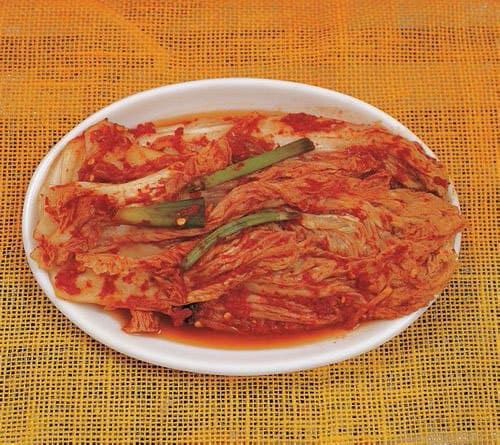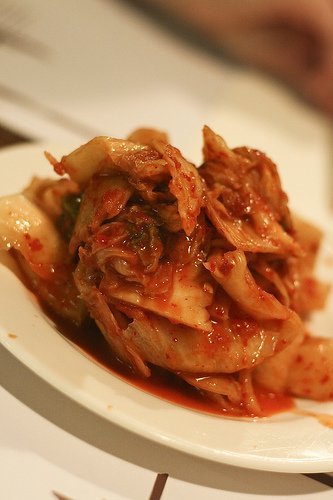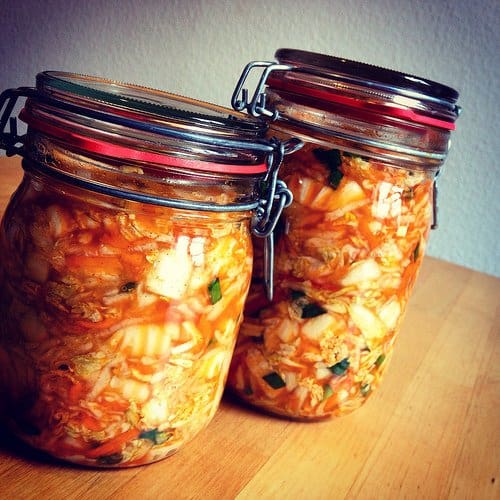Kimchi is a Korean condiment made from shredded cabbages pickled in spices and seasonings. This condiment is often served as a side dish as well as ingredients to other dishes. For instance, kimchi is added to ‘slaws, burgers, soups, fried rice and even quesadillas. Suffice it to say, kimchi is one versatile condiment.
Traditionally, kimchi is stored in a large clay pot that’s been buried in the ground. The cool ground temperature allows the kimchi to ferment and develop stronger flavors.

Kimchi has a long shelf life because it’s been salt-pickled. That said, it could still go bad when exposed to indoor air for too long. In fact, leftover kimchi will keep in the fridge for only 5 to 7 days. When kept in the freezer, leftover kimchi will keep for 2 to 3 months. That said, some Koreans believe kimchi never goes bad, it only ripens.
Still, never leave leftover kimchi sitting at room temperature for long. When you have leftovers, keep in the fridge immediately to limit exposure to air.
A sign that kimchi has “gone bad” is if takes on a too-sour taste. Now, kimchi that’s gone bad isn’t completely unusable. You can still use it in cooking. You can mix it in pancake batter, fried rice, or tofu stew.
The only time you should throw kimchi is if mold starts growing on it or it is starting to produce pungent odor. If say, you have a lot of kimchi in your hands, here is a step by step guide on how can you freeze kimchi:

How to Freeze Kimchi?
For bottled kimchi, it’s not a good idea to stick the bottle straight in the freezer. The glass bottle will shatter as the kimchi freezes. It’s best to repackage the kimchi in manageable servings using heavy duty plastic bags or even freezer-safe rigid containers. Just make sure the container is airtight to prevent freezer burn.
Water crystals could form into exposed or poorly packed kimchi and they will dilute the flavors of the condiment once it’s defrosted. Also, the melted water crystals will turn the kimchi soggy.
Using a clean spoon, spoon the product into the plastic container or plastic bag. If you’re using resealable plastic bags, squeeze as much air as you could before sealing the bag. Get a marker, label the package with the storage date and stick in the freezer.
The same method goes for homemade kimchi and leftover kimchi. Just pack the condiment in manageable portions before sticking in the freezer. This way, the kimchi won’t get soggy during thawing. For store-bought plastic-wrapped and unopened kimchi, you can stick the product directly in the freezer. If the pack’s been opened, you can either transfer the kimchi in a resealable container or seal the original packaging before sticking in the freezer.

How to Defrost Kimchi?
To defrost frozen kimchi, just transfer the product from the freezer to the fridge. Leave the condiment to thaw for several hours. The key here is to thaw the kimchi slowly to reduce flavor or texture changes. Since kimchi is traditionally served cold, you can enjoy this popular condiment as soon as it’s thawed completely. On the other hand, you can add frozen kimchi directly into cooking if say, you’re using it for stews and soups.
Summary
Kimchi is the perfect condiment for rich dishes because of its distinct acidity. It complements all types of foods particularly grilled meats and Korean barbecue! Now that you know how can you freeze kimchi, you can store this delicious condiment for future uses so you’ll never run out.